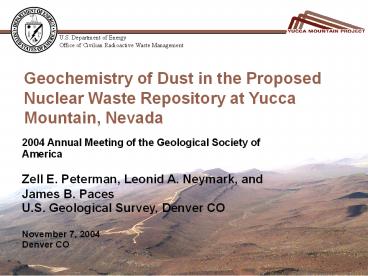Master Powerpoint Briefing - PowerPoint PPT Presentation
Title:
Master Powerpoint Briefing
Description:
Particulates from diesel exhaust. Salts from evaporated water ... Aerosols from lubricating oil, diesel oil, grease, hydraulic fluids, etc. ... – PowerPoint PPT presentation
Number of Views:95
Avg rating:3.0/5.0
Title: Master Powerpoint Briefing
1
Geochemistry of Dust in the Proposed Nuclear
Waste Repository at Yucca Mountain, Nevada
2004 Annual Meeting of the Geological Society of
America Zell E. Peterman, Leonid A. Neymark, and
James B. Paces U.S. Geological Survey, Denver
CO November 7, 2004 Denver CO
2
Yucca Mountain is a Ridge of Rhyolitic Tuff in
Southern Nevada (Looking South)
3
ESF Tunnel (Yellow), Cross Drift (Red), and
Conceptual Emplacement Drifts (Blue)
4
Construction of Underground Space Is a Dirty
Business
- Dust is the inevitable product of underground
mining and construction - Fine dust is a health hazard for workers in the
underground and must be controlled thru- - Ventilation
- Filtration
- Generation reduction by wetting at production
sites
5
Why is Dust Composition Important in a Nuclear
Waste Repository?
- Dust will accumulate on waste canisters and drip
shields during and after emplacement - Dust salts may dissolve in water that drips on
canisters or deliquesce in high humidity
environments to form brine droplets or films - These salts or saline waters may accelerate
corrosion of the canisters
6
Sources of Underground Dust
- Mining (TBM, Alpine miner, drill and blast, muck
haulage) - comminution of rock including fracture minerals,
vapor-phase minerals, alteration minerals (clays
and zeolites) - Particulates from diesel exhaust
- Salts from evaporated water
- Construction water (tagged with LiBr)
- Pore water migrates to tunnel walls and
evaporates leaving a salt halo - Abraded rubber and fiber from conveyor belts
7
Sources of Underground Dust (continued)
- Aerosols from lubricating oil, diesel oil,
grease, hydraulic fluids, etc. - Ferrous metals from variety of sources
- Concrete particles from emplacement and abrasion
of inverts - Salts from human effluents
- Dust from the surface transported into the
Exploratory Studies Facility (ESF) on materials
and by the supply air
8
Dust Collection
- Dust was vacuumed from the tunnel wall, trapped
by a cyclone, and deposited in a 250 mL sample
bottle attached to the cyclone - Several square meters of surface were vacuumed to
yield 200 to 400 grams of dust
9
Methods
- Chemistry of bulk dust size fractions by standard
rock analysis methods (XRF, ICPMS, gravimetric,
titration, combustion) - Chemistry of leachates by ion chromatography and
ICPMS - Mineralogy of soluble salt fraction
- Scanning electron microscope (SEM)
- XRD analyses of evaporated leachates
- Calculation of normative minerals using SALT NORM
(Bodine and Jones, 1986)
10
Particle Size Distribution of ESF Dust (shown in
mesh size)
11
Major and Minor Elements in Dust Size Fractions
Relative to Host Rock
12
Trace Elements in Dust Size FractionsRelative to
Host Rock
13
Major and Trace Element Enrichments in Dust
Relative to Rhyolite
- Major Elements
- FeO (introduced as metallic iron), CO2 (from
calcite veins) , Organic C and Cl (neoprene
abraded from conveyor belt etc.), and Cl (from
water) - Trace Elements
- Bi, Cd, Co, Cr, Mo, Ni, Sb, V, Zn (metallic
elements associated with construction and
materials introduced during construction)
14
Soluble Fractions of Surface and Underground Dust
- Underground dust contains a small amount of
soluble salts - Dust in main tunnel contains 0.370.18 (1 s)
weight percent (n66) - Dust in cross drift contains 0.170.17 (1 s)
weight percent (n18) - Surface dust contains a much larger amount of
soluble salts (Reheis, 2003) - Atmospheric dust collected at and near Yucca
Mountain contains 13.38.1 (1 s) weight percent
(n51)
15
Identification of Salt Minerals in Underground
Dust
- SEM examination for S and Cl in dust mounts
- halite, sylvite, gypsum, natroaulnite (also
pyrite, molybdenite, native sulfur identified) - No CaCl2 was identified
- XRD analyses of dried leachates
- halite, sylvite, calcite, gypsum, and bassanite
(2CaSO4H2O) - salammoniac NH4Cl
- mascagnite (NH4)SO4
- biphosphammite (NH4,K)H2PO4
- weddellite CaC2O42H2O
16
Identification of Salt Minerals in Underground
Dust (contd)
- Estimation of soluble minerals from water
leachates using SALT NORM (Bodine and Jones,
1986) - Carbonates (calcite, dolomite, pirsonnite)
- Nitrates (niter, soda niter, ammonia niter)
- Sulfates (glauberite, aphthitalite, thenardite,
anhydrite, syngenite, mascagnite) - Chlorides (halite, sylvite, salammoniac)
- Fluorides (fluorite, villiaumite)
- Phosphates (fluorapatite, hydroxyapatite,
wagnerite)
17
Salt Minerals Expected from Atmospheric Dust
Intrusion into Repository (Chemistry from NADP
Red Rocks Site Minerals from SALT NORM)
18
Salt Minerals Expected from Atmospheric Dust
Intrusion into Repository
19
Nitrate-Chloride Ratios
- Ratio of soluble nitrate-to-chloride is an
important parameter for corrosion - Critical weight ratio (NO3/Cl) is approximately
0.9 - Soluble salts in dust typically have NO3/Cl
ratios greater than 0.9 - Pore waters typically have NO3/Cl ratios less
than 0.9
20
Nitrate-to-Chloride Weight Ratios in Dust Salts
and Pore water
21
Conclusions
- Most of the underground dust is finely comminuted
rhyolite - Fine silicate particulates will neutralize acids
formed in the near-field environment (D.
Langmuir, 2004) - Soluble salts are more relevant to corrosion
issue - Soluble salts average less than 1 percent of the
underground dust - Atmospheric dust contains much larger amounts of
soluble salts (average13.3 weight percent) - Nitrate-chloride ratios of both underground and
atmospheric dust are favorable (greater than 0.9) - No CaCl2 was identified (none expected)

